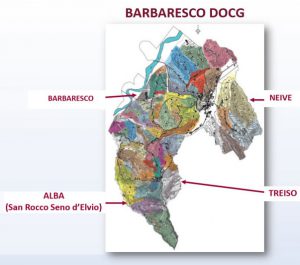
Posted: Saturday, 18 February 2023 13:45
Grandi Langhe 2023: MGAs of Barolo and Barbaresco

The three most common wine-related acronyms any Italian wine lover would be familiar with are IGT-Indicazione Geografica Tipica, DOC and DOCG- Denominazione di Origine Controllata e Garantita. They define the hierarchy of Italian wine Appellations (Piemonte does not have IGT wines). Rest are all Table wines!
A new term ‘MGA’ evolved in 2007 in Barbaresco and 2010 in Barolo to describe the vineyard and soil typicity giving different flavours and complexity. It may be displayed on the front labels of bottles but most wine drinkers- even those in the region might not yet be completely familiar with the significance of this acronym. It is doubtful whether wine lovers with any depth of knowledge in India and, in fact, most of the world outside Italy would be aware of full details. However, the Barolo/ Barbaresco producers are pleased and proud as the MGAs micro-define the wine region and the diverse terroir in more depth. It is time to get familiar with this new acronym doing rounds specifically for Barolo and Barbaresco premium wines.
MGA (Menzione Geografica Aggiuntiva) refers to a specific area officially defined within the production zone of Barolo or Barbaresco DOCG. Simply put, an MGA can be seen as the equivalent of the French terms cru or climat. Each area can be specific to a site or represent the whole comune like Serralunga d’Alba or La Morra.
MGAs of Barbaresco DOCG
 The studies and surveys were conducted for several years in order to define the MGAs. Barbaresco was ahead because it is a smaller appellation. Thus Barbaresco DOCG introduced them earlier in 2007 with a total of 66 MGAs. An earlier start perhaps is the reason why 95% of the producers use at least one MGA, with an average of 2 per winery. 53% of Barbaresco uses MGAs. Rabaja Bas is the smallest whereas Canova is the largest MGA.
The studies and surveys were conducted for several years in order to define the MGAs. Barbaresco was ahead because it is a smaller appellation. Thus Barbaresco DOCG introduced them earlier in 2007 with a total of 66 MGAs. An earlier start perhaps is the reason why 95% of the producers use at least one MGA, with an average of 2 per winery. 53% of Barbaresco uses MGAs. Rabaja Bas is the smallest whereas Canova is the largest MGA.
MGAs of Barolo DOCG
There are 170 officially recognized MGA in Barolo (plus an additional 11 comune MGAs). Understandably, it is as complex a task as the wines in any Barolo zone and can be daunting. Each MGA refers specifically to a delineated place and is named within Barolo and codified since 2010.
The DOCG of Barolo consists of 11 approved villages: Barolo, Castiglione Falletto, Serralunga d’Alba, Cherasco, Diano d’Alba, Grinzane Cavour, La Morra, Monforte d’Alba, Novello, Roddi and Verduno. Together, these five communities make up Barolo’s core villages. Novello and Verduno are gaining in prestige, while Grinzane Cavour, Diano d’Alba, Cherasco and Roddi, with their small production, are less important and are lesser-known villages. The five largest- La Morra, Serralunga d’Alba, Monforte d’Alba, Castiglione Falletto and Barolo are more relevant, especially in a country like India where Barolo and Barbaresco are viewed as brands that do not require much further details; the name and popularity of the producer and the marketing prowess of the importer are probably more important.
Half of the wineries have MGAs-each winery having an average of 2 MGAs with another 50% without any MGA. All 11 comunes (municipalities) of Barolo including Serralunga and La Morra (10%) use the Comunes as MGA. Listing the MGA on the label is optional.
Geographic names (Origins)
If you think MGAs are confusing, step back a little and think of names like Giacosa and Roggeri on the label. These are family name-based Origins. Some of the others are Baudana, Boschis, Roggeri, Ravera, Giacosa, Montersino, Rambone and Ronchi.
There are other geographic origins that are based on the site location-like when you see Cannubio, Rio Sordo and Boschetti in the labels. Boschetti, La Serra, Brumata, Torriglione, Cannubio, Rio Sordo, Casotto, Cascina, Trifolera and Montestefano are some such examples.
Of course, it gets confusing when they have Boschetti also as a producer’s name, e.g. ‘Azienda Agricola Cascina Boschetti Gomba Barolo’ which is from Boschetti site; or Giovanni Sordo Barolo founded by Giuseppe Sordo Barolo DOCG
Barolo and Barbaresco continue to be quite challenging wines and confusing in terms of understanding the labels and MGA has not made it easier to comprehend them but with all the complexity offered in the region, the structure may be useful for many ‘B’ lovers. Of course, single vineyards maintain the status quo.
If you really want to have a clear understanding of the MGAs, Sandro Minella, who conducted the Masterclass and is a part of the Academic Staff, recommends us to visit Barolo and Barbaresco Wine Academy where you will find more details. You may also write to info@barolobarbarescoacademy.com for details. You can take detailed courses of Level I and Level 2 and even become a Brand Ambassador for the Langhe wines that include Barolo and Barbaresco.
Subhash Arora







Great Subhash Arora, phantastic presentation !!!
CTG Trambusti Gigliola
from Florence (Tuscany- Italy )